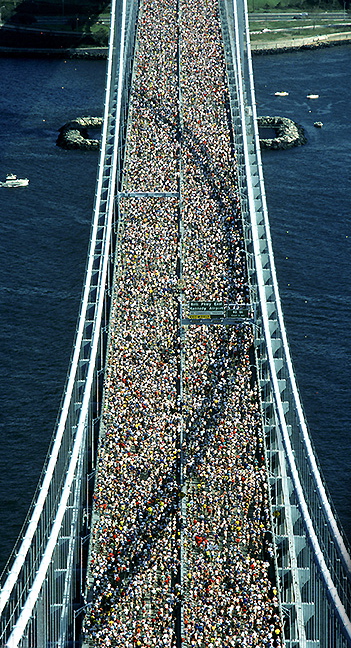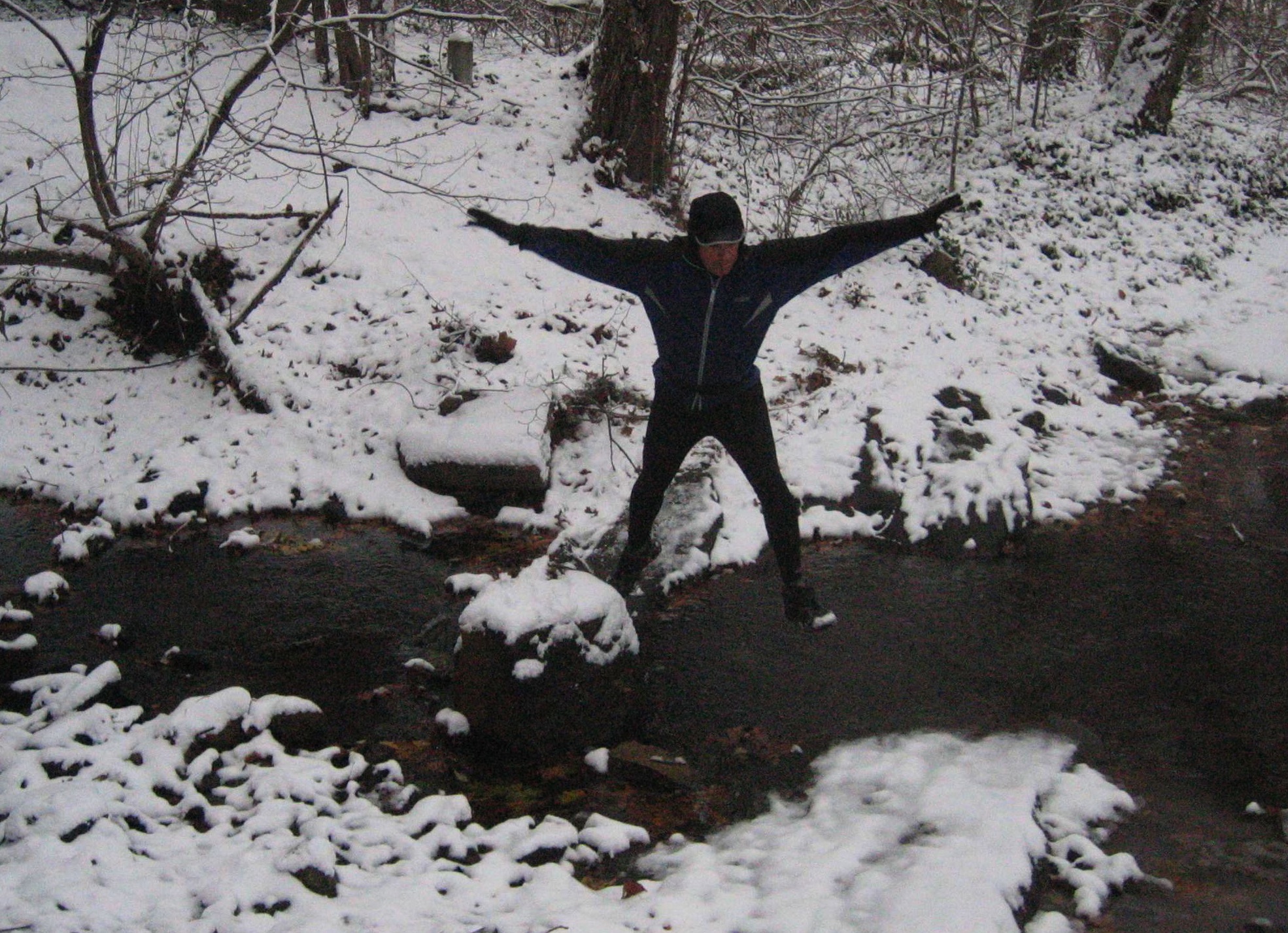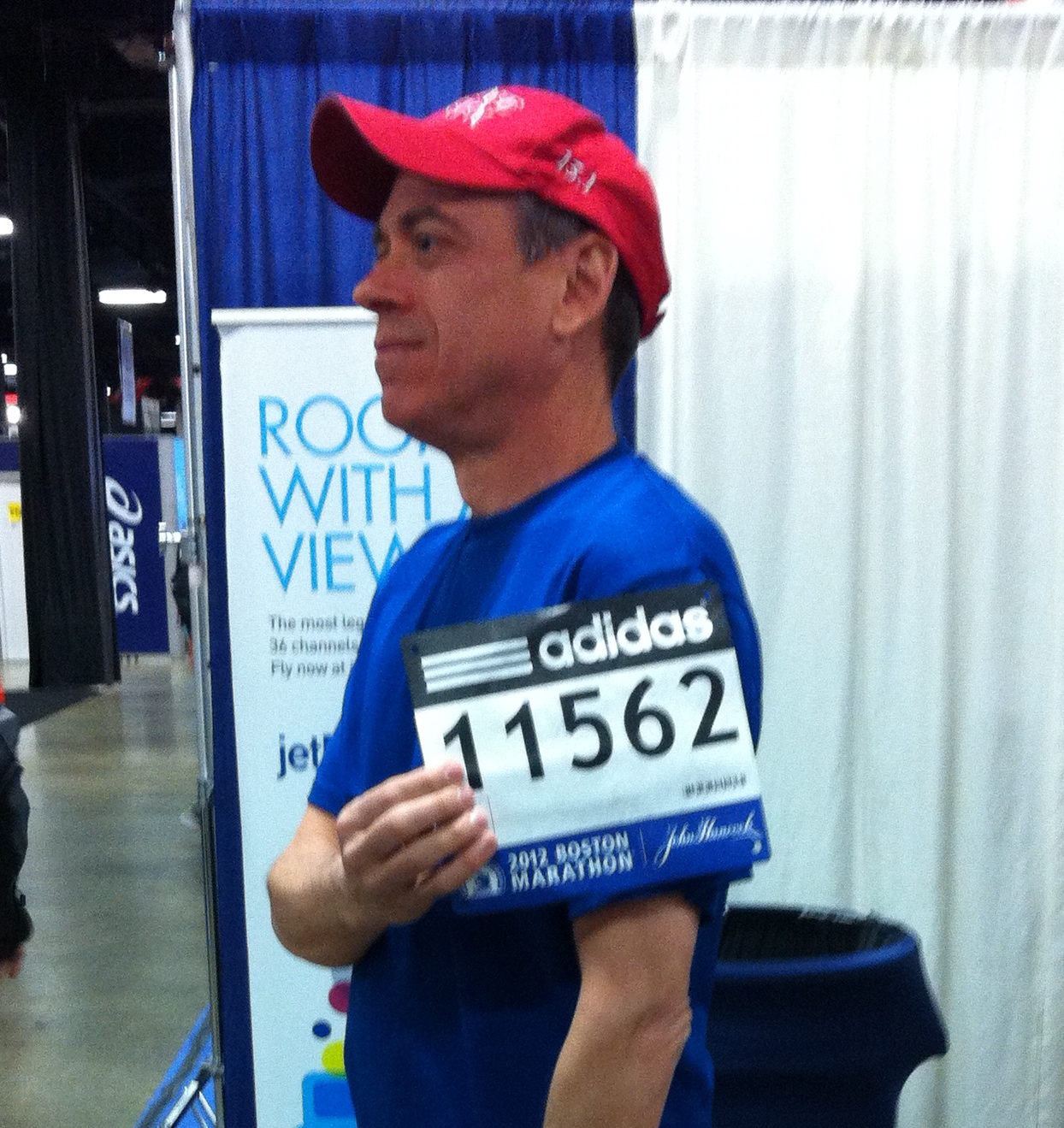
Pre race mug shot - because I needed a legal angle for the blog
Yeah, it was hot out there. The average temperature for Boston this time of year is 47 degrees. And runners favor such races with temps in the high 40s – low 50s.
The temperature yesterday, however, was 87 degrees at the finish line for the 116th running of the Boston Marathon for those of us in the middle of the pack. Elsewhere it was reported to have hit 89. And that, my friends, is a whole lot of hot.
When I first wrote about the Boston Marathon in 2007 I did so to wish others well as I pined to one day run fast enough to earn my entry ticket. And when I wrote a second time in 2009, I told my story of personal redemption after having finally qualified and run.
But this was not about redemption, or pining. There would be no eyes toward personal bests, or running fast enough to qualify for another Boston. This was, quite simply, the meteorological luck of the draw. People had trained for months on end, had made their plans, and travelled great distances to run the premier marathon in the world that is open to amateurs. Because after Boston in the pecking order, there is only the Olympic Trials.
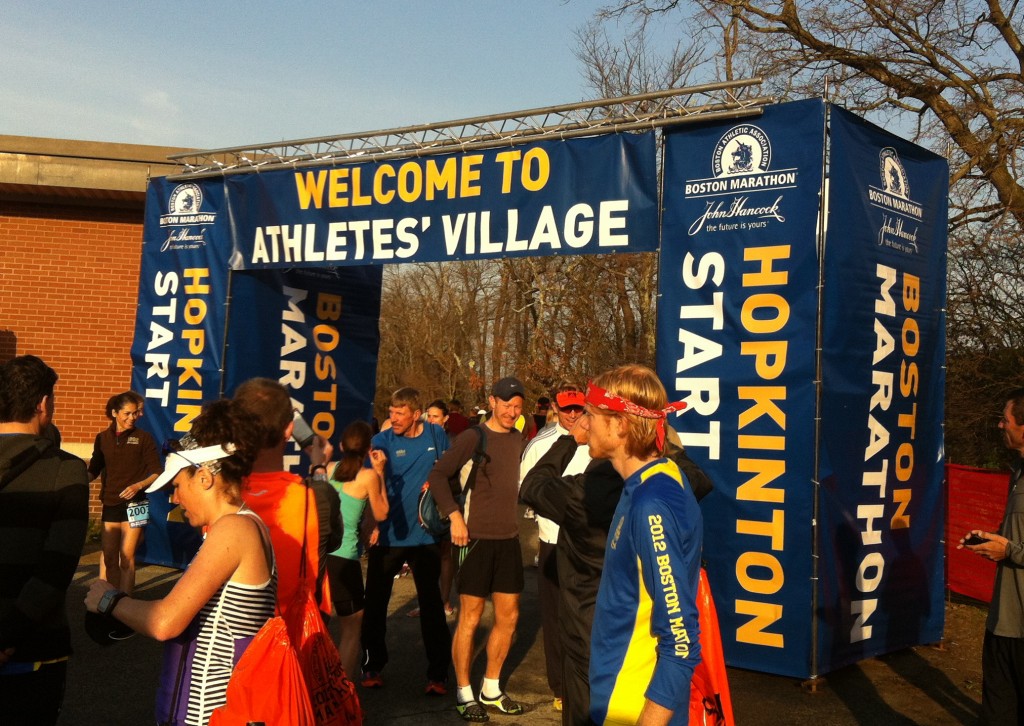 And so we went, with runners going off in three waves out of the rural suburb of Hopkinton at 10:00, 10:20 and 10:40 as the the thermometer soared up to 80. Very few took up the offer of deferring until next year. There were two rules of thumb: Drink a lot and adjust your running plan, or you would not see the finish line.
And so we went, with runners going off in three waves out of the rural suburb of Hopkinton at 10:00, 10:20 and 10:40 as the the thermometer soared up to 80. Very few took up the offer of deferring until next year. There were two rules of thumb: Drink a lot and adjust your running plan, or you would not see the finish line.
While I don’t usually take walk breaks in marathons, I knew this would be an exception. But I didn’t expect that I would take the first one after just four miles. Four miles?
And I took them every mile thereafter except for one (the last mile, which I refused to walk). I wasn’t alone, and knew if I didn’t start re-charging my batteries with those walks early on I was a candidate for the medical tent.
The odd thing about this race is that there was no sweet spot. No time to simply cruise. For most people that run this distance the first few miles are just to shake out the legs and anxiety. Miles 4-16 should be the comfort zone. Those moments never happened.
Brutal was the word for the day. When the sun disappeared for 30 seconds behind the sole cloud in the sky, a roar went up from runners and spectators alike that rippled down the course. Early on I heard the refrain from Highway to Hell blaring from speakers. There was nothing to do but laugh.

Photo credit: Lorianne DiSabato on Flikr
The crowds were nothing less than awesome and the water sprays were out in force – firemen with hydrant attachments, homeowners with hoses, kids with spray guns.
Since the early running goes through so many small towns — Ashland, Framingham, Natick, Wellesely and Newton — before hitting the big city, the route is a constant stream of homes and villages with local parties along the way. With 500,000 spectators, this is the the biggest event in New England. And the locals were doing what they could for us. Passing out water, passing out oranges, passing out support and passing out beer. And yes, you’re damn right I took some beer. It fortified me for Heartbreak Hill, part of the hills of Newton between miles 17 and 21.
It was during those walk breaks that the crowd really played a part, as I had written my name on my shirt. This is a twofer: The crowds love knowing who is in front of them and the runner gets support. So when I was walking, the chanting would start. Sometimes solo, but sometimes large groups urging me on. And that helped snap me out of some of the longer walk breaks deep into the race.
The view of the other runners in those late stages brought to mind images of refugees trudging toward safety. I saw more people walking up Heartbreak than running it, moving forward, forward, inexorably forward.
From today’s New York Times came this interview using the word of the day:
“This was the toughest marathon I’ve ever run, and I’ve done 5 Ironmans, 3 Bostons and about 20 marathons,” said Mark Williams, 45, of Richmond, Va. He said his time was 30 minutes slower than six months ago. “It was brutal.”
And this from Jason Argent on Twitter:
My 5th #BostonMarathon a brutally rough go in 90 degree temps. 45 mins off my time last yr. Just happy to be alive after that death march.
One of the problems the race organizers had was not knowing exactly how runners would handle the heat. There isn’t a lot of real-world data on the subject of running 26 miles in those temps. One striking example was the 2007 Chicago Marathon that was cancelled mid-race due to heat, when water stops ran out of the precious liquid. (Many early runners were grabbing two or three cups and dowsing themselves, leaving the back of the pack without.) I carried backup of fluids yesterday, just in case. But water seemed plentiful, at least from my middle-of-the-pack vantage point, and I drank so much Gatorade I felt like I was being prepped for a colonoscopy.
When I did hit the finish on Boylston Street in Boston’s Back Bay section I came in about 30-35 minutes off my expected finish time. But I wasn’t disappointed, as others did the same. Adding 30-45 minutes was normal according to most people I spoke to, and that includes top local runners capable of cracking three hours in average conditions.
Few runners train in such heat. Even those in hot weather climates like Florida or Arizona are likely to train early in the morning or after the sun goes down. But mid-day, with no time to acclimate to these temperatures because this is a spring marathon and not a fall race? To quote Donald Rumsfeld:
There are known knowns. These are things we know that we know. There are known unknowns. That is to say, there are things that we know we don’t know. But there are also unknown unknowns. There are things we don’t know we don’t know.
And one thing the vast, vast majority of runners didn’t know was how we would handle the heat. It turned out that there were 2,100 runners treated for dehydration out of 22,000 starters. As for the other 90% wondering if would could handle the heat: We can, and we did. But we might not be too keen on repeating the adventure.
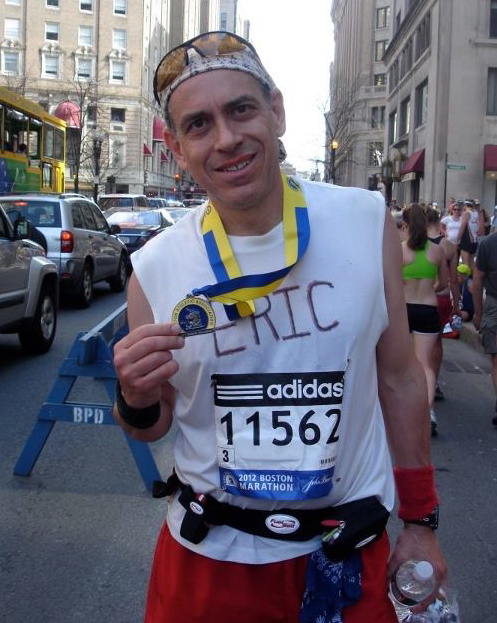
And now the legal part of this post. (I have to have one, don’t I?) When athletes toe the starting line of an event, they assume the risks of competing. And that includes dealing with the weather.
My finishers medal will now be placed in a prominent spot in my trophy room. Also known as the tie rack in my closet.
For those with an interest in running and the law, once upon a time I did a Blawg Review based on the NYC Marathon.
Lastly, for those who ran Boston yesterday, this video’s for you.
My legal posts can be followed with my Twitter handle @Turkewitz, but for the running, it’s @PaineToPain.
Elsewhere:
Surviving the Boston Marathon (The New Yorker)
Boston Marathon Deferrals: Here Are the Facts (Runners World)
Boston Marathon a Battle, from Start to Finish (Tom Renner)
…Nothing in my running bag of tricks – energy gels, water, Gatorade, alternating walking and running – seemed to do much good. The temptation to walk off crossed my mind frequently… [more at link]
Boston Marathon 2012: Mile by Mile (Mile Posts by Dorothy Beal):
You don’t hit the wall at the 8 mile mark. I knew it was the heat….Mile 21 was my first mile in the 10′s. I’m not sure the last time I saw a number in the 10′s…By Mile 23 I had started vomiting….[more at link]
RACE REPORT: Brian Adkins Finishes 2012 Boston Marathon (Marathon Brian):
…I had finished the 2012 Boston Marathon, 41 minutes slower than 2011′s performance in my first Boston run, but probably my proudest day as an athlete and event competitor….
The Boston Marathon: A Recap (I Dabble):
It was my slowest marathon to date, but is easily the one I am most proud of.
Boston 2012: The Hot One (Apple Crumbles):
…At 10K, people were already struggling. I wasn’t alone….
Race Report: Boston Marathon (Will Run for Beer):
…when I wrote on Sunday night of my revised goals for the race, I still thought I’d run a 3:20 and then come back here and be all “that was hard, but if you trust your training, you can do it.”
Instead I ran a 3:50 and honest to God considered dropping out. Of the Boston Marathon.
Lest you be wondering if the heat was really that big a deal, it was…
Too Hot to Handle: Boston Marathon Race Report (Runnrgirl’s Blog):
The first 3 miles …so i was bouncing along, pretty content for a while, and then i started feeling nauseous. i’ve battled nausea while running before so i thought it was still nerves and it would shake out as my body got used to running…the nausea led to some dry-heaving…
Boston Marathon Recap (linseyontherun):
I planned to crush the marathon. I aimed to run my best marathon by far, shooting for a goal between 3:15 and 3:18. That didn’t happen and normally, I’d look back on this marathon and be devastated. This year, I feel accomplished and am still in a bit of shock over how I persevered and made it to the finish line.
Baked in Boston (Sweet Victory):
Obsessions over my pace were replaced by obsessions over the ice bags and sprinklers that the fans of Boston had all over the course. I’d heard it before and now I know it’s true: these are the best marathon fans in the world. I ran from ice bag to ice bag, through sprinklers and hoses, doing everything possible to keep my core cool…
My Boston Marathon Lesson: Remember the Goal (Dan Taylor):
I finished my first Boston Marathon yesterday and want to capture the most important lesson I learned from that experience.
Although I learned the lesson in the excruciating heat of the Boston Marathon I know for me it’s a lesson that I’ll carry over into other parts of my life…
What NOT Running the Boston Marathon Taught Me (Run Brit Run):
Not running on Monday was one of the hardest decisions I’ve ever had to make. For 5 months, my life was training for Boston. Everything I did was planned around training runs. I barely went out, I spent an abnormal amount of time with my foam roller, and when people asked what my weekend plans were the response was always how long my long run was that week. Giving up the culmination of all of that hard work crushed me….
xx will update with good blogs posts as they are found xx

